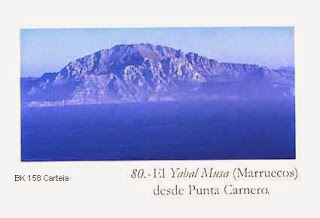PILLARS IV
(by the later classical writers)
What did
the classical authors know really about the straits of Gibraltar,
which they called the columns of Heracles.
Strabo 1st
century BC / 1st century AD
He quotes
for a part Euctemon. He writes in Geography III, 5,3:
“Close to the Pillars there are two isles,
one of which they call Hera’s Island; moreover there are some who call these
Isles the Pillars.”
Geography
III, 5,5:“… Again, some have supposed
that Calpe and Abilyx are the Pillars, Abilyx being that mountain in Libya
opposite Calpe which is situated, according to Eratosthenes in Metagonium,
country of a nomadic tribe; one of which they call Hera’s Island, are the
Pillars. Artemidorus speaks of Hera’s Island and her temple, and he says there
is a second isle, yet he does not speak of Mount Abilyx
or of a Metagonian tribe.”
Furthermore:
the region outside the Pillars is fertile. Passing the strait delivers some
difficulty. Strabo notices the sea-oak: That creature is present inside and
outside the pillars. It is covered with ahorns. He mentions an oracle to the
Tyrians ordering them to send a colony to the Pillars. The thought that “those Pillars which are in the temple of Heracles at Gades as the Pillars of Heracles
is less reasonable”. But this is exactly what happened! I will explain it
later. He talks also about Calpe as follows: “I mean Calpe, which, although its
circumference is not great, rises to so great height and is so steep that from
a distance it looks like an island.”
Strabo
tells us finally of a Phoenician ship off the west coast of Spain which, seeing
that it was being followed by a Roman vessel, deliberately went aground on
underwater rocks, causing the Italian galley to do likewise. When the Phoenician
captain returned home he was awarded the price of the boat and the cargo, he
had sacrified, as compensation.
Pomponius
Mela 1st century AD
I 27: …. This is followed by a very high mountain, of
the one that Spain can ascend on the opposite side, opposite is: This is Abila,
the other Kalpe, both together Pillars of Hercules.
He
describes also the separation of the mountains and the entry of the ocean.
Ptolemeus
2nd century AD
In his
Geography (IV 3,4+3,7) he distinguishes
Ad Septem Fratres (coordinates: L 7-40, W 35-50) from the Pillar of Abila
(coordinates L 7-50, W 35-40) locating the latter to the southeast of Ceuta. He mentions also
the place Exilissa.
Philostratus
2nd century AD
Around 170
AD he writes in the Life of Apollonius of Tyana (V,1):
“the extremity of Libya, which bears the name Abinna.”
Itinerarium
Antonini 3rd century AD
He makes a
distinction between the town Ad Septem Fratres and the Pillar (Monte del Hacko)
situated to the northeast of the town.
Avienus
4th century AD
In the verses
345-346 in Ora Maritima he talks about the town Abila.
Eustathius
4th century AD
Paraphrase
of Dionysius Periegetes:
“as for the Libyan (Pillar) it is called
Abenna by Barbarians, but Huntress in Greek.”
Orosius
5th century AD
Probably in
the year 414 AD he writes in Historiae adversus Paganos (T 2,94):
“fretum Gaditanum quod inter Habennae et
Calpis duo contraria sibi promuntoria coartatur. ’’ He describes here the straits of
Gadir, which narrow between the two opposite promontories of Abenna and Calpe.




